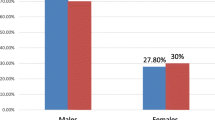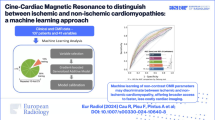Abstract
Objectives
To investigate the feasibility of automatic machine learning (autoML) based on native T1 mapping to predict late gadolinium enhancement (LGE) status in hypertrophic cardiomyopathy (HCM).
Methods
Ninety-one HCM patients and 44 healthy controls who underwent cardiovascular MRI were enrolled. The native T1 maps of HCM patients were classified as LGE ( +) or LGE (-) based on location-matched LGE images. An autoML pipeline was implemented using the tree-based pipeline optimization tool (TPOT) for 3 binary classifications: LGE ( +) and LGE (-), LGE (-) and control, and HCM and control. TPOT modeling was repeated 10 times to obtain the optimal model for each classification. The diagnostic performance of the best models by slice and by case was evaluated using sensitivity, specificity, accuracy, and microaveraged area under the curve (AUC).
Results
Ten prediction models were generated by TPOT for each of the 3 binary classifications. The diagnostic accuracy obtained with the best pipeline in detecting LGE status in the testing cohort of HCM patients was 0.80 by slice and 0.79 by case. In addition, the TPOT model also showed discriminability between LGE (-) patients and control (accuracy: 0.77 by slice; 0.78 by case) and for all HCM patients and controls (accuracy: 0.88 for both).
Conclusions
Native T1 map analysis based on autoML correlates with LGE ( +) or (-) status. The TPOT machine learning algorithm could be a promising method for predicting myocardial fibrosis, as reflected by the presence of LGE in HCM patients without the need for late contrast-enhanced MRI sequences.
Key Points
• The tree-based pipeline optimization tool (TPOT) is a machine learning algorithm that could help predict late gadolinium enhancement (LGE) status in patients with hypertrophic cardiomyopathy.
• The TPOT could serve as an adjuvant method to detect LGE by using information from native T1 maps, thus avoiding the need for contrast agent.
• The TPOT also detects native T1 map alterations in LGE-negative patients with hypertrophic cardiomyopathy.






Similar content being viewed by others
References
Bogaert J, Olivotto I (2014) MR imaging in hypertrophic cardiomyopathy: from magnet to bedside. Radiology 273(2):329–348
Maron BJ, Ommen SR, Semsarian C, Spirito P, Olivotto I, Maron MS (2014) Hypertrophic cardiomyopathy: present and future, with translation into contemporary cardiovascular medicine. J Am Coll Cardiol 64(1):83–99
Mentias A, Raeisi-Giglou P, Smedira NG et al (2018) Late gadolinium enhancement in patients with hypertrophic cardiomyopathy and preserved systolic function. J Am Coll Cardiol 72(8):857–870
Hashimura H, Kimura F, Ishibashi-Ueda H et al (2017) Radiologic-pathologic correlation of primary and secondary cardiomyopathies: MR imaging and histopathologic findings in hearts from autopsy and transplantation. Radiographics 37(3):719–736
McDonald RJ, Levine D, Weinreb J et al (2018) Gadolinium retention: a research roadmap from the 2018 NIH/ACR/RSNA workshop on gadolinium chelates. Radiology 289(2):517–534
Robinson AA, Chow K, Salerno M (2019) Myocardial T1 and ECV measurement: underlying concepts and technical considerations. JACC Cardiovasc Imaging 12(11 Pt 2):2332–2344
von Knobelsdorff-Brenkenhoff F, Prothmann M, Dieringer MA et al (2013) Myocardial T1 and T2 mapping at 3 T: reference values, influencing factors and implications. J Cardiovasc Magn Reson 15(1):53
Gottbrecht M, Kramer CM, Salerno M (2019) Native T1 and extracellular volume measurements by cardiac MRI in healthy adults: a meta-analysis. Radiology 290(2):317–326
Leiner T, Rueckert D, Suinesiaputra A et al (2019) Machine learning in cardiovascular magnetic resonance: basic concepts and applications. J Cardiovasc Magn Reson 21(1):61
Neisius U, El-Rewaidy H, Nakamori S, Rodriguez J, Manning WJ, Nezafat R (2019) Radiomic analysis of myocardial native T1 imaging discriminates between hypertensive heart disease and hypertrophic cardiomyopathy. JACC Cardiovasc Imaging 12(10):1946–1954
Neisius U, El-Rewaidy H, Kucukseymen S et al (2020) Texture signatures of native myocardial T1 as novel imaging markers for identification of hypertrophic cardiomyopathy patients without scar. J Magn Reson Imaging 52(3):906–919
Wang J, Yang F, Liu W et al (2020) Radiomic analysis of native T1 mapping images discriminates between MYH7 and MYBPC3-related hypertrophic cardiomyopathy. J Magn Reson Imaging 52(6):1714–1721
Dafflon J, Pinaya WHL, Turkheimer F et al (2020) An automated machine learning approach to predict brain age from cortical anatomical measures. Hum Brain Mapp 41(13):3555–3566
Le TT, Fu W, Moore JH (2020) Scaling tree-based automated machine learning to biomedical big data with a feature set selector. Bioinformatics 36(1):250–256
Su X, Chen N, Sun H et al (2020) Automated machine learning based on radiomics features predicts H3 K27M mutation in midline gliomas of the brain. Neuro Oncol 22(3):393–401
Zhou H, Hu R, Tang O et al (2020) Automatic machine learning to differentiate pediatric posterior fossa tumors on routine MR imaging. AJNR Am J Neuroradiol 41(7):1279–1285
Authors/Task Force members, Elliott PM, Anastasakis A et al (2014) 2014 ESC guidelines on diagnosis and management of hypertrophic cardiomyopathy: the task force for the diagnosis and management of hypertrophic cardiomyopathy of the European Society of Cardiology (ESC). Eur Heart J 35(39):2733–2779
Xu J, Zhuang B, Sirajuddin A et al (2020) MRI T1 mapping in hypertrophic cardiomyopathy: evaluation in patients without late gadolinium enhancement and hemodynamic obstruction. Radiology 294(2):275–286
Raisi-Estabragh Z, Izquierdo C, Campello VM et al (2020) Cardiac magnetic resonance radiomics: basic principles and clinical perspectives. Eur Heart J Cardiovasc Imaging 21(4):349–356
Baeßler B, Mannil M, Maintz D, Alkadhi H, Manka R (2018) Texture analysis and machine learning of non-contrast T1-weighted MR images in patients with hypertrophic cardiomyopathy-Preliminary results. Eur J Radiol 102:61–67
Schofield R, Ganeshan B, Fontana M et al (2019) Texture analysis of cardiovascular magnetic resonance cine images differentiates aetiologies of left ventricular hypertrophy. Clin Radiol 74(2):140–149
Olson RS, Bartley N, Urbanowicz RJ, Moore JH (2016) Evaluation of a tree-based pipeline optimization tool for automating data science. Proc GECCO 485–492. https://doi.org/10.1145/2908812.2908918
Langdon WB, Poli R, McPhee NF, Koza JR (2008) Genetic programming: an introduction and tutorial, with a survey of techniques and applications. Stud Comput Intell 927–1028. https://doi.org/10.1007/978-3-540-78293-3_22
Galati G, Leone O, Pasquale F et al (2016) Histological and histometric characterization of myocardial fibrosis in end-stage hypertrophic cardiomyopathy: a clinical-pathological study of 30 explanted hearts. Circ Heart Fail 9(9):e003090
Ando K, Nagao M, Watanabe E et al (2020) Association between myocardial hypoxia and fibrosis in hypertrophic cardiomyopathy: analysis by T2* BOLD and T1 mapping MRI. Eur Radiol 30(8):4327–4336
Acknowledgements
We thank the Intellispace Discovery Platform (Philips Healthcare, Best, The Netherlands) to further facilitate our radiomics research.
Funding
This study was financially supported by the 1–3–5 project for disciplines of excellence of West China Hospital, Sichuan University (ZYGD18019).
Author information
Authors and Affiliations
Corresponding authors
Ethics declarations
Guarantor
The scientific guarantor of this publication is Prof. Zhen-Lin Li.
Conflict of interest
Two authors of this manuscript (Tian-Jing Zhang and Hai-Xia Li) are employees of Philips Healthcare, and they are participants in the analysis of the data. The remaining authors declare no relationships with any companies whose products or services may be related to the subject matter of the manuscript. Zhen-Lin Li of West China Hospital controls the data.
Statistics and biometry
No complex statistical methods were necessary for this paper.
Informed consent
Written informed consent was obtained from each participant.
Ethical approval
Institutional Review Board approval was obtained from the Biomedical Research Ethics Committee of West China Hospital.
Methodology
• Prospective
• Diagnostic study
• Performed at one institution
Additional information
Publisher’s note
Springer Nature remains neutral with regard to jurisdictional claims in published maps and institutional affiliations.
Wan-Lin Peng and Tian-Jing Zhang contributed equally to this work and should be considered as co-first authors.
Chun-Chao Xia and Zhen-Lin Li contributed equally to this work and should be considered as co-corresponding authors.
Supplementary Information
Below is the link to the electronic supplementary material.
Rights and permissions
About this article
Cite this article
Peng, WL., Zhang, TJ., Shi, K. et al. Automatic machine learning based on native T1 mapping can identify myocardial fibrosis in patients with hypertrophic cardiomyopathy. Eur Radiol 32, 1044–1053 (2022). https://doi.org/10.1007/s00330-021-08228-7
Received:
Revised:
Accepted:
Published:
Issue Date:
DOI: https://doi.org/10.1007/s00330-021-08228-7




